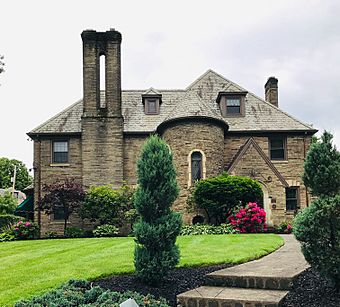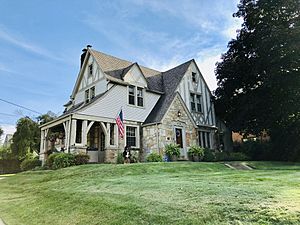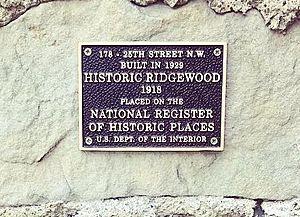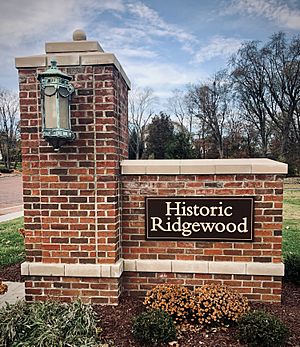Ridgewood Historic District facts for kids
Quick facts for kids |
|
|
Ridgewood Historic District
|
|

French Normal Revival Home in Ridgewood, Canton, Ohio
|
|
| Location | Canton, Stark County, Ohio |
|---|---|
| Area | 2.5 sq mi (6.5 km2) |
| Built | 1918 |
| Architectural style | Colonial, Tudor Revival |
| NRHP reference No. | 82001489 |
| Added to NRHP | December 19, 1982 |
The Ridgewood Historic District is a special neighborhood in Canton, Ohio. It's known for its beautiful old homes. These houses were designed by famous architects in the early 1900s. They are built in what's called the "Revival style."
The neighborhood also has its original brick streets and unique streetlights. Because of its important history and architecture, the Ridgewood Historic District was added to the U.S. National Register of Historic Places on December 19, 1982. This means it's officially recognized as a place worth protecting.
Contents
What Makes Ridgewood Special?
The Ridgewood Historic District is a neighborhood with many homes. It's located in Canton, Ohio, about 20 blocks from the city center. This area was developed between 1918 and 1940. Most of its important buildings were built from 1920 to 1930.
A man named George A. Leonard and his company developed the area. Mrs. Leonard named it "Ridgewood" after a place she liked in Springfield, Ohio. Out of 190 buildings, 58 were built after World War II.
Homes and Design
Most of the homes in Ridgewood were built between 1919 and the start of the Great Depression. The very first house, built in 1919, was designed by John Sherwood Kelly. Another early home, built the same year, was designed by Herman Albrecht. It was one of the first Tudor Revival style homes there.
Over the next ten years, architects like Herman Albrecht and Charles E. Firestone designed many homes in the district. John Kelly, working with his brother-in-law Arthur Brothers, designed almost two dozen houses.
The homes in Ridgewood are usually large. They are set back from the street. The neighborhood has many old trees and pretty plants. Most streets are in a grid pattern. But some streets, like University Avenue, are curved. This makes the lots different shapes and creates nice views. It also helps keep traffic slow.
You won't find any stores, gas stations, or big parking lots here. This helps keep the neighborhood feeling like a quiet, old residential area.
Unique Architecture
Even though the homes were built around the same time, they don't all look the same. Most of them were designed by architects. They show many different shapes and styles. These styles are part of the European Revival movement. Architects during this time loved to use ideas from older European buildings.
The builders used high-quality materials and craftsmanship. You can see windows with special beveled and leaded glass. Roofs have many different shapes and are made of slate in various colors. There's also hand-cut stone and special brickwork. You might even spot small towers or fancy decorations on the roofs. These details come from the original styles that inspired the homes. The neighborhood feels like a step back in time to how wealthy people lived before the Great Depression.
Here are some examples of the types of buildings you can find:
- Tudor Revival Homes
- Mitchell House (1921)
- Ball House (1929)
- Giessen House (1928)
These homes often have special plasterwork called pargetting. They feature leaded windows and arched doorways. Many have stone on the first floor and half-timbered designs on the second. They also have unique chimneys.
- French Norman Revival Homes
- Harris House (1930)
- Fischgrund House (1927)
- Obermeier House (1930)
These houses often have dormer windows and window bays. They feature plastered entries and hipped roofs. These roofs are sometimes like the mansard style. They also have multiple roof levels.
- Georgian Revival Homes
- Lavin House (1930)
- Blake House (1930)
These homes often have pedimented entries with fan lights. They feature dentilled cornices and shuttered windows. They are typically made of brick.
Some buildings in the district are a bit different. For example, the Fawcett House (1921) was built to attract people to the new neighborhood. It has a roof that looks like thatch and many small-paned windows. It mixes old and new styles. The Lehman/Belden House (1890) is the oldest in the area. It has elements of the Queen Anne and Eastlake styles.
Even with these differences, the Ridgewood Historic District has a consistent, slightly European feel. It shows some of the best suburban architecture from its time in America.
Why Ridgewood is Important
The Ridgewood Historic District is important for a few reasons. It's the only neighborhood in Canton built during this time with architect-designed Revival style buildings. These styles were very popular in the early 1900s.
It's also important because it shows off local features. The streetlights and paving bricks were made by companies right in Canton. Many homes were designed by local architects. This helps preserve a part of Canton's history for the future.
The Ridgewood area was planned in stages between 1918 and 1927. The Leonard Agency developed it. The western part of the land was once a farm. The eastern part was called the Bellwood addition.
Most streets in Ridgewood were paved with bricks. These bricks came from Canton's own Metropolitan Paving Brick Company. This company was the largest maker of paving bricks in the country! Their bricks were used in big tunnels in New York and on the Indianapolis speedway. The street lights in Ridgewood were also made by a Canton company, Union Metal Manufacturing Company. They made fancy streetlights for nice neighborhoods all over the country.
Famous Architects of Ridgewood
Several local architects were key to creating the unique look of Ridgewood.
- Charles E. Firestone was a leading architect in Canton from 1915 to 1959. He designed many important buildings like Timken High School and Fawcett Stadium. He designed twelve homes in Ridgewood, including three for himself.
- Herman Albrecht worked in Massillon and Cleveland. He designed 14 buildings in Ridgewood. He also worked on parts of Aultman Hospital and the Massillon Museum.
- John Sherwood Kelly started his own business in 1925. He designed many buildings in northeast Ohio. With his brother-in-law, Arthur M. Brothers, he designed 18 homes in Ridgewood.
- Louis Hoicowitz was an immigrant from Russia who became a successful home builder. He designed 13 of the most impressive homes in Ridgewood. He was known for adding towers to his designs.
Ridgewood shows Canton's growth as an industrial city. Its buildings helped make the city look grand. The most important building period was from 1920 to 1930. This is when Ridgewood's unique style was set. The tree-lined, brick streets show off the Colonial and Tudor Revival styles. These were the most popular choices for homeowners.
Homes built from 1930 to 1940 also used similar materials and styles. They fit in well with the earlier homes. Even homes built after World War II (from the 1950s to today) still use basic Colonial and Tudor Revival styles. While they might not have all the fancy details, they still help keep the neighborhood's look consistent.
Who Lived in Ridgewood?
Many important people from Canton lived in Ridgewood when it was first built. This included managers from big companies like Republic Steel and the Timken Roller Bearing Company. Two members of the Timken family, Robert and Henry, lived there.
Managers from other Canton industries also lived in Ridgewood. This included companies making things like stamping, enameling, and rubber products. Many professionals like doctors, lawyers, bankers, and teachers also made their homes in this special neighborhood.






